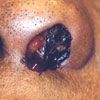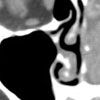Middle-Aged Woman With Epistaxis, Facial Pain and Swelling, and Otalgia
For 2 weeks, a 49-year-old woman has had mild, intermittent epistaxis with left-sided facial pain, swelling, and otalgia; the severity of the bleeding has increased during the past 24 hours. She also has congestion of the left naris of 1 month's duration.

Figure 1

Figure 2
The Case: For 2 weeks, a 49-year-old woman has had mild, intermittent epistaxis with left-sided facial pain, swelling, and otalgia; the severity of the bleeding has increased during the past 24 hours. She also has congestion of the left naris of 1 month's duration.
Her medical history includes a myocardial infarction 2 years earlier, hypertension, gastroesophageal reflux disease, and epilepsy. She underwent a supracervical abdominal hysterectomy because of fibroids. She has a family history of hypertension. She denies tobacco and illicit drug use and reports minimal alcohol consumption.
Vital signs are normal. A large pearl-gray paranasal mass completely obstructs the left naris. The oropharynx is clear, and the posterior pharynx is symmetrical without any plaques or exudates. There is significant pain and facial swelling over the left maxillary sinus but no anesthesia over the V2 distribution (maxillary branch of the trigeminal nerve). The tympanic membranes are clear; the landmarks are visible on the right but not on the left because of serous effusion. Neither the insertion of the otoscope bilaterally nor tragus pulling causes pain. No preauricular or cervical adenopathy is noted; no neck masses are palpable. The cranial nerves are normal, with no evidence of Horner syndrome. The remaining physical findings are unremarkable.
What is the most likely cause of this patient's symptoms?
- Polyp
- Papilloma
- Inverted papilloma
- Carcinoma
(Answer and discussion begin on next page.)
Answer: Sinonasal undifferentiated carcinoma

Figure 1
DISCUSSION: A facial CT scan showed opacification of the maxillary, ethmoidal, and sphenoidal sinuses, consistent with a left paranasal sinus mass (Figure). The mass caused destruction of the bony architecture of the left inferior and medial nasal turbinates with extension into the nasopharynx.
This patient has sinonasal undifferentiated carcinoma (SNUC)-a rare, highly aggressive, clinico-pathologically distinctive carcinoma of uncertain histogenesis that typically presents with locally extensive disease. Patients usually have multiple symptoms, including epistaxis, nasal congestion, headaches, otalgia, cranial nerve palsies, visual disturbance, and facial pain.
The workup includes:
- CT/MRI of the head, sinuses, and neck to below the clavicles to rule out base of skull erosion and extension into other sinuses.
- Chest CT and bone scans to screen for distant metastasis.
- Indirect and direct nasopharyngoscopy to assess the primary tumor as well as to provide a means for biopsy.
- Complete blood cell count, basic metabolic panel, liver function tests, Epstein-Barr virus (EBV) viral capsid and antigen, and EBV DNA (to differentiate between SNUC and nasopharyngeal carcinoma).
Patients require intensive multimodality therapy, including radiotherapy, chemotherapy, and sometimes surgical resection. Despite aggressive treatment, the prognosis remains poor. The median survival is less than 18 months, with a 5-year survival of less than 20%. Local recurrence is common.

Figure 2
In this patient, CT scans of the head, neck, chest, abdomen, and pelvis as well as MRI scans of the head and neck showed no evidence of metastasis. She is currently undergoing radiotherapy and chemotherapy.
DIFFERENTIAL DIAGNOSIS OF SNUC
Intranasal polyps appear as fleshy, smooth-surfaced, translucent masses in the nasal cavity and usually originate in the superior nasal vault. They may arise in the ethmoidal region or from the maxillary sinus ostium (antral-choanal polyps), the turbinates, or the septum. Polyps are often associated with allergic rhinitis or chronic sinusitis. Symptoms include nasal congestion, ear pain, headaches, and epistaxis. Medical treatment consists of corticosteroid nasal sprays (fluticasone, triamcinolone, budesonide), oral corticosteroids, and antihistamines. Polypectomy and endoscopic sinus surgery are surgical options.
Papilloma and inverted papilloma are associated with malignancy and also have locally aggressive growth patterns, which make their removal technically difficult. Sinonasal papillomas differ from the more common inflammatory polyps in that the latter are actually reactive lesions, not tumors. An accumulation of intracellular fluid causes sinonasal papillomas. These papillomas are typically unilateral. They can destroy adjacent areas by spreading along the mucosa, and they tend to recur after excision.
Nasal papillomas are true neoplasms, which arise from the nasal respiratory epithelium. These papillary, exophytic, verrucoid lesions generally originate from the nasal septum.
Once papillomas invert into the underlying connective tissue, they are termed "inverted" papillomas. Inverted papillomas generally arise from the lateral nasal wall. Grossly inverted papillomas appear more opaque than inflammatory polyps because of a thick epithelial layer. They typically have irregular surfaces that resemble warts and have invaded an adjacent sinus at initial pre-sentation. They are most commonly located in the middle turbinate; however, they also are found in the maxillary and ethmoidal sinuses and rarely in the nasopharynx.
Surgical management is the mainstay of treatment of both papillomas and inverted papillomas. The specific surgical procedure is based on the extent, location, and presence of malignancy.
Nasopharyngeal carcinoma is associated with alcohol and tobacco use. It is more common than SNUC but still rare, with an incidence of 0.5 to 2 persons per 100,000 in the United States. However, in a number of areas (China, Hong Kong, Taiwan, Kenya, the Philippines, Singapore, Tunisia, Sudan, and Uganda), it is the most common tumor and accounts for 20% to 25% of all cancers. Risk factors are salt-cured foods, preserved meats (nitrates), EBV infection, and genetic predisposition.
Nasopharyngeal carcinomausually originates in the lateral wall of the nasopharynx, which includes the fossa of Rosenmller. It can then extend in or out of the nasopharynx to the other lateral wall or posteriosuperiorly to the base of the skull or the palate, nasal cavity, or oropharynx. Later, it typically metastasizes to cervical lymph nodes. Distant metastasis to bone, lung, mediastinum and, rarely, the liver may occur. Typical symptoms include nasal congestion, discharge or bleeding, ear pain or change in hearing, headaches, and neck swelling.
Treatment of nasopharyngeal carcinoma consists of concomitant chemotherapy and radiotherapy. Surgery is useful for the diagnosis and staging of nasopharyngeal carcinoma. However, most cases are not amenable to surgical resection because of the anatomical constraints of the nasopharynx.